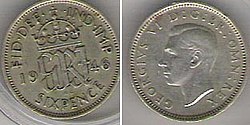United States

In the US, the bit is equal to 12+1⁄2¢, a designation which dates from the colonial period, when the most common unit of currency used was the Spanish dollar, also known as "piece of eight", which was worth 8 Spanish silver reales. $1⁄8 or 1 silver real was 1 "bit". [1] [2]
With the adoption of the decimal U.S. currency in 1794, there was no longer a U.S. coin worth $1⁄8, but "two bits" remained in the language with the meaning of $1⁄4. Because there was no 1-bit coin, a dime (10¢) was sometimes called a short bit and 15¢ a long bit. (The picayune, which was originally 1⁄2 real or 1⁄2 bit (6+1⁄4¢), was similarly transferred to the US nickel.)
In addition, Spanish coinage, like other foreign coins, continued to be widely used [3] and allowed as legal tender by Chapter XXII of the Act of April 10, 1806 [4] until the Coinage Act of 1857 discontinued the practice.
Robert Louis Stevenson describes his experience with bits in Across the Plains , (1892) p. 144: [5]
In the Pacific States they have made a bolder push for complexity, and settle their affairs by a coin that no longer exists – the bit, or old Mexican real. The supposed value of the bit is twelve and a half cents, eight to the dollar. When it comes to two bits, the quarter-dollar stands for the required amount. But how about an odd bit? The nearest coin to it is a dime, which is, short by a fifth. That, then, is called a short bit. If you have one, you lay it triumphantly down, and save two and a half cents. But if you have not, and lay down a quarter, the bar-keeper or shopman calmly tenders you a dime by way of change; and thus you have paid what is called a long bit, and lost two and a half cents, or even, by comparison with a short bit, five cents.
"Two bits" or "two bit" continues in general use as a colloquial expression, for 25¢, or a quarter dollar as in song and catchphrase "Shave and a Haircut, two bits." As an adjective, "two-bit" describes something cheap or unworthy.
Roger Miller's song "King of the Road" features the lines: Ah, but two hours of pushin' broom buys an / Eight by twelve four-bit room referring to signs stating "Rooms to let, 50¢."
In the early 1930s, Crown Records was a US record label which sold records for only 25¢. The company advertised on their sleeves, "2 Hits for 2 Bits."
Another example of this use of "bit" can be found in the poem "Six-Bits Blues" by Langston Hughes, which includes the following couplet: Gimme six bits' worth o'ticket / On a train that runs somewhere.…
The expression also survives in the sports cheer "Two bits, four bits, six bits, a dollar … all for (player's name), stand up and holler!"
The New York Stock Exchange continued to list stock prices in $1⁄8 until June 24, 1997, at which time it started listing in $1⁄16. It did not fully implement decimal listing until January 29, 2001.

